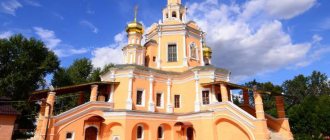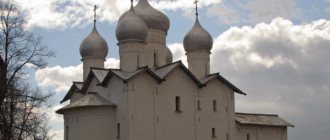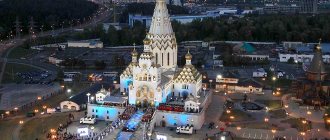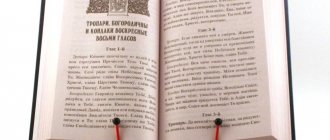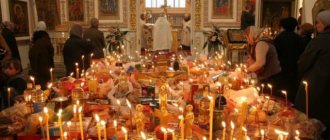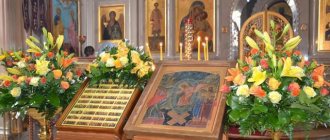| Blgv. Princess Anna of Novgorod. Icon of the 1970s, nun Juliania (Sokolova), Sergiev Posad. |
Anna of Novgorod, baptized Irina, in the world Ingigerda
(+ 1056), blessed princess, reverend, wife of the blessed Grand Duke Yaroslav the Wise and mother of the blessed Prince of Novgorod Vladimir Yaroslavich Memory on February 10 on the day of death, October 4 together with the memory of the blessed. Vladimir Yaroslavich [1], in the Cathedral of Novgorod Saints
The eldest daughter of the Swedish king Saint Olaf Shetkonung (994-1022), nicknamed the “Most Christian King”. In 1008, the king, his family and squad received holy baptism. She received an education that was exceptional for a woman of that time: she studied the Holy Scriptures, literature, and history. She was a true daughter of Scandinavia of the Viking Age and therefore from an early age she enjoyed great freedom, participated in the public life of her homeland, traveled, received guests, and was good with weapons. Historical sources especially note her intelligence, courage, and great influence on others.
In 1018, at the behest of her father, she married the one “who was worthy of his friendship” - Prince of Novgorod, blessed Yaroslav the Wise. As a dowry, she brought the city of Aldeigaborg (now the village of Staraya Ladoga) to the Russian land.
Having become the Grand Duchess of Kyiv in 1019, she gave all the strength of her soul and heart, all her blessed gifts to her new homeland, being a faithful assistant and adviser to her husband in his affairs. Once, when the hired Norwegian guard was indignant and asked the Grand Duchess to be a mediator between them and Yaroslav, she agreed, but warned that she would protect her husband’s interests. When his brother Mstislav Tmutarakansky came out against the Grand Duke with his army, Irina offered to resolve the dispute with a military duel with her, but Mstislav replied that he was not used to fighting women - and gave in to his brother.
The Grand Duke often had to go on long campaigns and trips, during which Irina remained in Kyiv, managing affairs.
Irina had a great influence on good relations with the northern countries of Europe. She sheltered in Kyiv the exiled sons of the English king Edmund Ironside, Edmund and Edward, as well as the Norwegian prince Magnus. He did not return to his homeland until the Grand Duchess was convinced that the Norwegians would give him the throne and his rights would be respected. The Russian state at that time played a significant role in the life of Europe, its authority and influence were higher than ever - and this was largely due to the Grand Duchess.
Already during her lifetime she became famous for her virtue and piety. Saint Hilarion of Kiev in his famous “Sermon on Law and Grace” writes, addressing the already deceased Saint Vladimir, the baptist of Russia: “Look at your daughter-in-law Irina, look at your grandchildren and great-grandchildren, how they live, how God protects them, how they keep the faith that you bequeathed to them, as they praise the Name of Christ!”
She became the mother of seven sons and three daughters. Her sons are especially famous: Holy Prince Vladimir of Novgorod, Grand Duke Izyaslav of Kiev, Svyatoslav of Chernigov, Vsevolod of Pereyaslavl.
Irina’s daughters, like their father, mother and brothers, were raised in a. The chronicler reports that Yaroslav “sown bookish words” in the hearts of people close to him. The Grand Duchess taught the children their native language, and they perfectly understood the Scandinavian sagas that the Varangian warriors sang at the prince’s court. The daughters of Irina and Yaroslav became queens: Anna - French, Maria - Hungarian, Elizabeth - Norwegian. It is known that the Grand Duchess founded a monastery in Kyiv in the name of her patroness, the Great Martyr Irina, and, according to the custom of that time, she had to not only take care of it, but also manage it.
In 1045, she went to Novgorod to visit her son Vladimir to lay the foundation stone for a cathedral in the name of St. Sophia the Wisdom of God. In Novgorod, Grand Duchess Irina took monastic vows with the name Anna. This was the first tonsure in the grand ducal house; with him began the tradition of tonsuring Russian princes and princesses after they had fulfilled their duty as rulers of the people. Here, in Novgorod, the holy princess Anna died on February 10, 1056 [2].
Relics and veneration
The relics of St. Anna were buried in the Novgorod St. Sophia Cathedral. Soon the body of her son, the noble Prince of Novgorod Vladimir, rested next to them.
On October 4, 1439, Saint Euthymius of Novgorod had a miraculous apparition (see the Cathedral of Novgorod Saints for more details), after which on this day a special requiem service was established for the Russian princes and archbishops of Novgorod buried in the St. Sophia Cathedral and all Orthodox Christians - the beginning of the celebration of the memory of Saints Anna, her son Vladimir Yaroslavich, and the Council of Novgorod Saints. On the ancient icons of the saint, which at the beginning of the century were kept in the Novgorod bishop's house, the name of Anna was depicted under September 5 and October 4. It is also unknown at what time the celebration of the saint was established on the day of her repose - February 10.
At the beginning of the century, the relics of the blessed princess rested openly in the Novgorod St. Sophia Cathedral. At that time, it was mentioned that her memory would be celebrated on February 10 and October 4 [3].
After the revolution, the saint's relics were taken away from the believers. In 1991, the city museum returned them to the Church along with another greatest shrine - the miraculous Icon of the Mother of God. Nowadays the relics of the Venerable Anna of Novgorod openly reside in the Novgorod Church of the Holy Apostle Philip.
The Life of Noble Anna of Novgorod
Reverend Anna was the eldest daughter of the Swedish king Olof Shetkonung, whom his contemporaries also called “the most Christian king.” He ruled Sweden from 994 to 1022. Together with his wife, the monarch accepted the Christian faith and holy water baptism in 1008; his example was also followed by the entire royal squad and family members.
The eldest daughter Anna, who bore the name Ingigerda before her baptism, received a comprehensive education from early childhood, which was not typical for women of that era. In addition to the Holy Scriptures, she studied history, literature and other sciences that were previously considered necessary exclusively for men. Even then it was noticeable that the girl had a huge influence on those around her thanks to her intelligence and courage.
Since the girl was a descendant of the Vikings, this affected her character - from an early age she was distinguished by her love of freedom, she was not forbidden to take part in the public life of her country, and also to travel accompanied by a small retinue. She not only studied literacy and literary works, but also masterfully wielded weapons and sat perfectly in the saddle.
In 1017, King Olof decided to marry his eldest daughter to the Russian prince Yaroslav the Wise, calling him one who was truly worthy of his friendship. As a dowry for his daughter, the monarch gave the Swedish city of Aldeigaborg, which was later renamed Staraya Ladoga. The young princess converted to Orthodoxy before her wedding and received the name Irina.
In the person of the Swedish princess, Yaroslav the Wise received not only a caring wife, but also an intelligent adviser, who spent all her strength and resources on strengthening her new homeland. In those days, there were many hired soldiers in the service of the Russian prince, and one day the Norwegian soldiers began to express their discontent and rebel against Yaroslav, asking Irina to become a mediator in resolving this conflict. The princess agreed, but immediately said that she would completely and completely defend the interests of her husband.
Another story about Irina’s heroism has survived to this day. Yaroslav's brother, Mstislav of Tmutorakan, opposed the Grand Duke with a huge army, and then the princess invited him to fight with her. To which Mstislav replied that he does not fight women, and reluctantly, he gave in to his brother.
The great merit of the Grand Duchess is that during her reign Rus' acquired great authority among its European neighbors thanks to its wise and far-sighted policy. Irina sheltered the sons of the King of England, as well as the Norwegian Prince Magnus, and did not let him go until she was convinced that in his homeland he would be given all the honors due to his status and given the throne, which he was supposed to inherit after his father.
The reign of Kievan Rus by Yaroslav and Irina was a period of extraordinary rise of the state. It was then, on the initiative of the prince and princess, that the first collection of legislative provisions in Rus' was created. Yaroslav also introduced the obligation for clergy to teach children to read and write, and the first school began to function in Veliky Novgorod.
In addition to participating in the social and political life of the state, Irina devoted a lot of time to spiritual affairs. On her initiative, the monastery of the Holy Great Martyr Irene was founded in Kyiv, in whose activities she took an active part.
During her life with Yaroslav the Wise, the princess gave birth to ten children, whom she independently taught both Russian and Swedish. She paid special attention to the spiritual education of her sons and daughters, instilling in them the foundations of Christian morality from infancy.
The children of Yaroslav and Irina became famous people who did a lot for the further development and prosperity of Rus'. Of these, it is worth noting such personalities as Vladimir Novgorodsky, Svyatoslav Chernigovsky and Izyaslav Kyiv. The princess's daughters married European monarchs. So, Anna became the wife of the king of France, and Elizabeth was given as a wife to the Norwegian monarch.
Yaroslav and Irina sought to make Kievan Rus an organic part of European Christianity; under their rule, churches and monasteries were erected throughout the state, and a lot of time was devoted to the spiritual education of their subjects. Singers were invited especially from Greece to teach Russian church ministers how to sing Christian hymns.
Since the Grand Duke often had to leave the capital on business, the princess took over all management of Kiev; she enjoyed authority and love from both wealthy citizens and the poor. Already in those days, Irina became famous for her virtue and pious life, and even Metropolitan Hilarion cited her as an example to other princesses as a model of a Christian wife and housekeeper.
After the death of her beloved husband, Irina went to her son in Novgorod, where they planned to lay the foundation for a cathedral in the name of St. Sophia the Wisdom of God. There she announced her decision to take monastic vows, taking the name Anna. In the grand-ducal family, this was the first case after which Russian rulers developed a tradition of going to a monastery after they finished fulfilling their duties as rulers.
Until her death, Anna of Novgorod performed spiritual work and died in 1056. The Grand Duchess was buried in St. Sophia Cathedral. Her son, Prince Vladimir of Novgorod, was soon buried next to her.
Role in international relations
Ingigerda had a great influence on the relations of Rus' with the countries of Northern Europe.
After the conquest of England by the Danes in 1016, the sons of the English king Edmund Ironside and the nephews of King Edward the Confessor, the English princes Edward and Edmund fled first to Ladoga, then to Novgorod, then to Kiev to Yaroslav and Ingigerda, and then to Hungary.
Her ex-fiancé, the exiled Norwegian king Olaf II, and his young son stayed in Novgorod for a long time. As they say, during Olaf’s stay in Novgorod, Ingigerda “had a secret love affair with him”[10]. Ingigerda convinced Olaf to leave his son Magnus in Rus'. Prince Magnus returned to his homeland only when the princess was convinced that the Norwegians would give him the throne of his father, who died immediately after returning to Norway in 1030.
Irininsky pillar, surviving from the Irininsky monastery in Kyiv
Sometimes it is stated [ by whom?
] that she taught her children the Scandinavian languages, and they knew the sagas.
Texts of prayers
The prayer book contains canonical texts approved by the Russian Orthodox Church, which are recommended to be used when addressing the holy princess Anna of Novgorod. However, there will be nothing terrible if during prayer a person utters words that come from the heart.
It is better to pray in front of the image of the Grand Duchess, which is first consecrated in the temple. It is also recommended to purchase church candles or a lamp and light them during the ritual.
Troparion
Having risen from the west like a sky-bright star,/ you were deemed worthy to accept the Orthodox faith,/ bringing forth blessed fruit to the Russian land,/ the holy blessed princess Anno,/ Christ is at the heart of all with whom thou hast loved,/ Whom preserving justifications and laws;/ and today is thy all-holy memory Celebrating, // we accept the remission of sins through your prayers.
Translation: Having shone in the west like a heavenly star, you were worthy to accept the Orthodox faith, in which you brought blessed fruit to the Russian land, holy noble princess Anna, you loved Christ with all your heart, keeping His commandments and laws, therefore today celebrating your most holy memory, sins We receive forgiveness through your prayers.
Kontakion
Today in your bright memory/ Great Novgrad is rejoicing,/ calling all the faithful to brightly celebrate your memory,/ and we now, spiritually jubilant,/ joyfully glorify you and pray:/ holy I am faithful to Princess Anno,/ stand before the Holy Trinity/ pray to deliver Veliky Novgrad and the whole Russian land // from all troubles and circumstances and we will all be saved.
Translation: On the day of your blessed memory, Veliky Novgorod rejoices, convening all believers to brightly celebrate your memory, and now, spiritually triumphant, we joyfully glorify you and pray: “Holy Blessed Princess Anna, standing before the Holy Trinity, pray for the deliverance of Veliky Novgorod and the whole earth Russian from all troubles and adversities, and about the salvation of us all.”
Family
| Ingigerda - ancestors |
sons
The origin of the wife of one of the sons - the German princess Oda, daughter of Leopold - is a controversial fact in terms of belonging to the Staden family (rulers of the North March) or the Babenbergs (rulers of Austria before the Habsburgs). It is also controversial whose wife Oda was - Vladimir, Svyatoslav or Vyacheslav. Today the dominant point of view is that Oda Leopoldovna was the wife of Svyatoslav and came from the Babenberg family[15]. DaughtersAnna, Anastasia, Elizaveta and Agatha
Controversial issues in genealogy
|
Iconography
There are several types of icons that depict the pious Anna of Novgorod. On some, the Grand Duchess is depicted in full height and in robes befitting her princely position. On others, the saint is already depicted in monastic vestments, with a scroll in one hand. You can purchase the image of St. Anna of Novgorod in any church store or order it online.
Role in government affairs
Ingigerda probably played a significant role in her husband’s politics and government affairs. “The Saga of Eymund” tells us that Yaroslav sent her to lead the army he sent against Bryachislav. Later, being captured, she acted (albeit under duress) as a peacemaker in a dispute between princes Yaroslav and Bryachislav, who agreed with her decision. She was also assigned the role of arbiter in further disputes between these princes.
According to the Saga of Eymund, she personally, together with Earl Rognvald, the son of Ulf, took part in the attempt to assassinate King Eymund. Before the murder attempt, Eymund spoke of her like this:
| ...—I don’t trust her because she is smarter than the King (Yarisleif = Yaroslav), but I don’t want to shy away from talking with her. |
Biography
Ingigerda, Princess of Sweden, was to marry King Olaf II of Norway - as a guarantee of peace between Sweden and Norway in accordance with the decision of the Thing in Uppsala in 1017. The wedding was supposed to take place in the fall on the border of the two states on the banks of the Elv River. In accordance with the agreements reached, in the fall of 1018, Olaf II arrived at the border to meet with the bride and her father, but they were not there. The messengers sent to Sweden brought disappointing news: in the summer, ambassadors from the Novgorod “King Yaritsleiv” arrived to Olaf Shetkonung; the Swedish king gave his daughter in marriage to the future Kiev prince and ruler of Rus' Yaroslav (the Wise), the son of Vladimir Svyatoslavich, who was then reigning in Novgorod. Olaf II married Ingigerda's half-sister Astrid.
Ingigerda arrived in Novgorod in the summer of 1019.
Judging by the “Sagas of Saint Olaf” by Snorri Sturluson, according to the marriage contract, Princess Ingigerda received as a dowry the city of Aldeigaborg (until 1703 Ladoga, now the village of Staraya Ladoga) with adjacent lands, which, according to the hypothesis of A. M. Sjögren, in the west received with Since then, the name of Ingria (the land of Ingigerda, in Finnish pronunciation - “Inkerinmaa”), and at the request of Ingigerda, the jarl of Västergötland Rögnvald Ulvsson, her relative on the maternal side, was appointed mayor (jarl) of Ladoga (Aldeigaborg)[7][8].
In “The Strand of Eymund” there is no mention of Ingigerda’s dowry; there is only a mention that Earl Rongvald owned Aldegioborg and remained in possession of it even after the conclusion of a peace treaty between Yaroslav and Bryachislav.
In Novgorod, Ingigerda switched to the Eastern (Orthodox) rite under the name Irina (consonant with Ingigerda).
Ingigerda was the second wife of Yaroslav, since the first wife of the Russian prince was captured by the Polish king Boleslav in 1018 and, together with Yaroslav’s sisters, was taken to Poland forever.[9] Presumably, it was the first wife who gave birth to Yaroslav’s son Ilya, who died in childhood.
